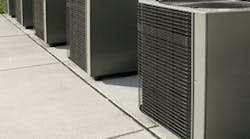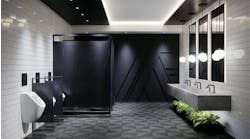Maintaining your HVAC systems not only protects the equipment – it also protects the people in your building from discomfort and IAQ concerns, and protects you from a lawsuit. There are many ways to make sure that indoor air is kept at appropriate levels:
- Keep an eye on the air vents – you can find out if mold or other pollutants are entering your occupied space.
- Watch for a musty odor.
- Keep in touch with tenants/occupants, and ask them to participate in surveys regarding air quality.
- Listen to people’s complaints and take them seriously.
In addition to keeping IAQ in check, routine maintenance can also lower utility costs and reduce equipment-replacement costs. Check out these tips from a variety of sources about HVAC maintenance and preservation.
Replace Filters (every 1-6 months)
Filters should be replaced regularly. Inspect them routinely for a few months and then decide, based on what you see, how often they should be replaced.
A New Generation of HVAC Equipment
High energy costs and growing environmental concerns drive the investigation of emerging technologies for the HVAC industry. The Arlington, VA-based Air-Conditioning and Refrigeration Technology Institute provides leadership and guidance to help identify and support the basic research needed to achieve the next level of HVAC equipment and components. Here are some things the organization is currently working on …
Smaller-Diameter Tubes for Heat
Exchangers
Small-diameter tubes allow for compact heat-exchanger designs that could provide more efficient heat transfer and reduce airside fan-power requirements; however, the smaller tubes may increase power requirements for the compressor. The question: Will smaller-diameter tubes provide greater overall HVAC system energy efficiency? One thing researchers are paying particular attention to is how the system performs at high outdoor temperatures when the refrigerant is operating near (or in) a supercritical state. The goal is to develop safer, cost-effective, and more energy-efficient high temperature lift space-conditioning and water-heating systems with minimal impact on the environment.
Materials for Heat Exchangers
The design of heat exchangers for air-conditioning, refrigeration, and energy-recovery systems has a significant impact on HVAC energy efficiency, capacity, cost, and size. Fairly traditional designs for heat exchangers include fin-and-tube, shell-and-tube, or plate-type heat exchangers that use copper and/or aluminum for tube-and-fin construction; however, recent advances in material science have yielded novel concepts in the use of other materials (lattice frame metals and alloys, carbon and graphite foams, plastic and polymeric materials, ceramics, and other materials) for heat exchangers that may increase heat transfer, reduce heat-exchanger size, or reduce heat-exchanger cost. Researchers are working on identifying novel materials suitable for use in heat exchangers for various HVAC applications, including comfort cooling, refrigeration, heat wheels, and energy recovery. Metal foam and hybrid novel designs will be fabricated, tested, and modeled.
Electro-Osmosis for Dehumidification
Air-conditioners cool the air, wring out moisture, and return the air to a moderate temperature. The process of over-cooling (to approximately 55 degrees F.) is inefficient since air is comfortable at around 70 degrees F. In theory, an air-conditioner delivering 70-degree F. air can be 50-percent more efficient than one that cools to 55 degrees F; however, in practice, efficiency gains are more moderate. Scientists and engineers are looking for methods of dehumidifying air without overcooling it (“decoupling” the dehumidification from the cooling process). Electro-osmosis is being investigated as an effective method of providing dehumidification. It’s primarily for residential applications, but the concept can be applied to commercial and industrial application, too.
When an electrical voltage is applied across a porous membrane, ions will be attracted from one terminal to another, and water will be dragged along in the process. While the process is microscopic, if enough membranes are piled together, the amount of moisture moved can be significant. The question: Can advances in materials yield membranes that make this concept technically and economically feasible for dehumidification?
Evaporator coils are a place that mold grows best. In addition to constant dampness, the supply side of the coil is in contact with outside air and the dirt that isn’t caught by filters.
The condenser coil degrades quickly because of dirt. It doesn’t have an effect on indoor air quality, so cleaning it at the same time you clean the evaporator coil will improve energy efficiency.
Coils soiled with microbial growth are hard to clean. A cleaning product with an appropriate dwell time is required to eliminate the micro-organisms. Built-up fungal growth is difficult to clean from metal surfaces, but don’t use an aggressive cleaner. Keeping the coils clean from the start will cut down on the time you spend on maintenance. Antimicrobial treatments are a good option to interrupt the growth of mold.
Inspect Fan, Bearings, and Belts (twice annually)
Even though fan, bearing, and belt operation don’t have a direct impact on IAQ, you should still inspect these pieces as part of your preventive-maintenance plan. Cleaning the blades on a small fan can take an hour or more; cleaning larger fans, especially those with multiple wheels on a single shaft, can take quite a while.
Check to see if fan motors are running in the wrong direction. This may not be obvious because fans can still supply flow if they’re running backwards. Clear labels on the fan housing, pulleys, the motor, and wires can prevent this problem.
Self-lubricating bearings on fans need the bearing cassette replaced when they fail. Look for lots of noise, vibration, or heat coming from the bearing. Greased ball bearings are occasionally found in packaged units; their most common problem is over-greasing, which can be as damaging as under-greasing.
Belts should be aligned to prevent wear. Maintain proper tension; loose belts slip on the pulley wheels, causing torque loss and rapid wear. Belts that are too tight put an extreme load on the motor and fan shaft bearings, causing premature failure.
Inspect Area Around Air Intake (twice annually)
Water can pool around air-handlers, and mold can grow there. Mold near the air intake means that spores could be sucked into the ventilation system and brought into your building. Check for standing water around the air-handler.
Fix Leaks in Cabinet and Supply Duct (annually)
Annual check-ups should contain a search for air leaks, a replacement of screws or latches, and patching or replacing gaskets. Cabinet and duct reliability is particularly important on the supply-air side, where high pressure can force air out of a small crack.
Clean and Adjust Dampers (annually)
Improper damper operation is one of the most common problems in HVAC equipment, and this can negatively affect indoor air quality and increase utility use.
Operating properly, dampers keep the compressor from running when the outside air temperature is lower than approximately 60 degrees F. If they’re not kept clean and lubricated, they stick, denying free cooling potential or overloading the cooling coil with too much hot outside air.
All movable surfaces should be cleaned and lubricated. Afterwards, a damper should be run through the full range. Then, you should check the setpoint.
Clean Air Ducts (every 2 years)
The National Air Duct Cleaners Association (NADCA) recommends inspecting supply side and return air ducts every 2 years (once per year in hospitals). If you find dirt, clean the ducts.
The Stimulus Package & HVAC
If maintenance just isn’t cutting it for your HVAC systems anymore, it might be time for an upgrade. Did you know that you could be eligible for a tax deduction or stimulus energy-efficiency credits of up to $1.80 per square foot for improving the energy efficiency of your building (or designing high efficiency into new buildings)?
The Energy Policy Act of 2005 (EPAct) includes a tax deduction for investments in energy-efficient commercial building property, designed to significantly reduce the heating, cooling, water heating, and interior lighting energy costs of new or existing buildings. The equipment must be placed into service by Dec. 31, 2013. To qualify for the full deduction, you must make investments designed to reduce energy costs by at least 50 percent. A partial deduction of 60 cents per square foot is available for investments in lighting, heating and cooling, or the building envelope that are designed to reduce energy costs by at least 16 2/3 percent.
Section 1331 of the EPAct provides for a deduction for energy-efficient commercial buildings that reduce annual energy and power consumption by 50 percent compared to ASHRAE standards. The deduction equals the cost of energy-efficient equipment installed during construction, with a maximum deduction of $1.80 per square foot. Additionally, a partial deduction of 60 cents per square foot is provided for lighting, HVAC, hot water, and the building envelope.
Owners of new and existing buildings (placed in service prior to the date of enactment) may earn a partial deduction of 60 cents per square foot per system for upgrading one or two major building sub-systems (lighting, heating and cooling, or the building envelope). These deductions apply to new buildings placed in service between the date of enactment and Dec. 31, 2013, or retrofits to existing buildings during the same time period.
Energy-efficient heating, cooling, ventilation, and hot-water equipment is partially qualifying property, within the meaning of Section 2.01 of Notice – 160920-05 (Notice 2006-52) that satisfies both of these conditions:
- The property is installed as part of the heating, cooling, ventilation, and hot-water system.
- It’s certified that the heating, cooling, ventilation, and hot-water systems will reduce the total annual energy and power costs with respect to combined usage of the building’s heating, cooling, ventilation, hot-water, and interior lighting systems by 16 2/3 percent or more (meeting the minimum requirements of Standard 90.1-2001). The required 16 2/3-percent reduction must be accomplished through energy and power cost reductions for the heating, cooling, ventilation, and hot-water systems.
For more information, visit www.capitalreviewgroup.com.


